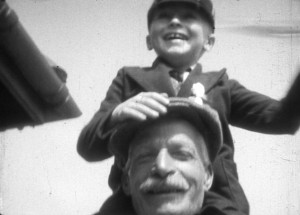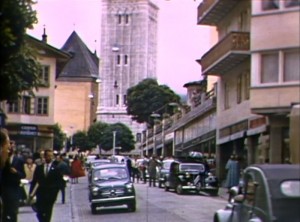"Item is an audio-visual production of Dr. Willinsky's trip to Israel. In the form of a travelogue, Willinsky accompanies footage of landmarks, ruins and the local population with audio commentary. The production includes a brief discussion of the formation of the state of Israel and features various cities, such as, Jerusalem and Tel-Aviv. Sadie [Willinsky] is occassionally spotted in the footage interacting with locals and visiting the homes of friends." Ontario Jewish Archives.

"Made by local amateur filmmaker Charles Scott, the film documents civic and public life in Norwich leading up to World War II and immediately following its conclusion. Beginning in 1933, Scott records acrobats, tightrope walkers and trapeze artists at the Norwich Carnival. The 1933 Armistice Parade features soldiers marching through the streets, halting at the eleventh hour. In 1934, Scott shows the Lord Mayor's Sunday celebrations at the Cathedral, as well as highlights from that year's Carnival. In 1935, Norwich celebrates the silver jubilee of King George V with decorations, parades, a military salute and an air display. January 1936 sees Norwich City Football Club taking on Chelsea in an FA Cup match at the newly built Carrow Road Stadium, with Scott capturing some of the action from his position behind the goal at the River End. Later that year, Scott returns to the Norwich Carnival once again, this time to catch an appearance by Hollywood starlet June Clyde. Norwich celebrates the coronation of King George VI with an extravagant street procession in May 1937. In 1938, with Britain gearing up for war, the Air Raid Precautions team practise fire-fighting and rescues, and test a new extension ladder. Following a break for wartime service, Scott returns to his film in 1946, documenting Battle of Britain Week by visiting the graves of servicemen and recording celebrations and parades in Norwich. Scott's film concludes with a visit to the home of prize-winning model engineer W.F.A. Way, who demonstrates some of his models on his garden track" (EAFA Database).

"Everyone knows a woman's penchant for a bargain, and this time it is father's favorite shaving soap - in quantity. Storage is a problem, but to a good housewife this can soon be solved. The trouble is, she fails to tell father. Still sleepy after his vigorous morning "one-two-threes," he quickly and incautiously, opens the "storage chest." When several cans of pressurized soap go tumbling against the hard surfaces of the bathroom fixtures, disastrous, and hilarious, things can happen" PSA Journal, Oct. 1963, 40.

"An eye for topical touches and a persistence that would shame the most aggressive news cameraman are responsible for Terry Manos's success in recording the V-E Day activities in New York City. Without the aid of a telephoto lens and balked at every turn by finicking guards, Mr. Manos's camera nevertheless caught the full flavor of the celebration in Times Square as well as some amazingly sharp studies of the personalities who participated in the program at Central Park. For ignoring the theoretical limitations often ascribed to the 8mm. camera and producing a well knit movie of a great historical event, praise is due to an enterprising amateur." Movie Makers, Dec. 1946, 488.
"Stephen F. Voorhees's 400 ft. travel film of Italian architectural scenes deserves placement in this list because it combines three factors but rarely brought together in pictures of this type. First, the photography is extraordinarily good, not only with reference to the routine requirements of exposure and focus but because it is artistic throughout and the composition never descends to the casual or the "snap shot" level. Second, Mr. Voorhees's film has a natural and easy continuity, jogging amiably through Venice and its environs, much as a traveler might do himself, pausing for a bit of incidental human interest and catching a scene that the filmer felt was unusual but presenting it without any preliminary flourishes, as one friend who might have said to another in the course of a stroll, "Don't miss that, by the way," pointing to something seen on the way. Last of the three things, so unusual to find combined, is a professional study, made by the filmer, himself a great architect, preserving those details which he wished to bring from northern Italy for later possible use. The great Colleoni statue is studied from many angles. Details of tiles and other wall ornamentations are offered and buildings are presented from one viewpoint after another. Yet all of this is done unpedantically and the nonprofessional audience is not aware that this subtle architectural record is more than a delightful travel film." Movie Makers, Dec. 1931, 658.

Kodachrome travelogue showing daily life and architecture in Italy.
"The film begins at a women's hairdressers. The manager asks one of the hairdressers to dinner that evening but she refuses as she has a customer, Mrs Blowers, who requires longer visits. At this the manager appoints Jane, a fellow hairdresser to take the appointment. Jane looks at the portrait of her fiance. We follow as the portrait dissolves into the real man. He works with cars and is informed that he has lost his job. Back at the hairdressers and Mrs Blowers arrives for her appointment. What starts as 'just a trim' becomes a longer matter. The clock shows 7.15 PM, closing time at the hairdressers. Jane loses her temper with her customer and insults her. The woman responds, stating that she will be making a complaint. On her way out Jane is informed that her customer was a stakeholder in the business. Jane meets with her boyfriend and they agree to share their bad news at a café. Later Jane discusses her situation with her friend but still despairs at her predicament. We see her writing a letter to her fiance, returning his ring and ending their engagement. She posts the letter. The next day at work Jane is informed of her week's notice. She begins cutting a young girl's hair. Outside one of the employees has alerted all about a fire. Jane notices smoke at her door. She covers the child and carries her out of the building but collapses from the smoke. The next sequence shows her in hospital. She is visited by her boyfriend and we see that she is wearing her engagement ring. At home recovering, she is visited by Mrs Blowers. This is where the film ends abruptly" (MACE Online Archive).
"'Japan and Its People,' Dr. Roy Gerstenkorn's educational class winner, was a pictured visit to the homes and temples of Japan. Ignoring the cities in his search for the story of the Japan that is not known to the average visitor the doctor penetrated the towns and smaller communities. His picture was awarded a high rating on its photography as well as on his treatment of the subject. After the showing of this picture before the Los Angeles Motion Picture Forum last summer the local school authorities requested and received permission from the doctor to make a duplicate of it for school purposes." American Cinematographer, Jan. 1938, 27-28.
"Jeannie is the little girl in the house where too much of the family income is spent for purposes other than family. With the aid of the court Jeannie is assigned to a Home where she can have the things she needs and toys and playmates. Perhaps we all know the story but each one tells it differently, arriving at a happy ending. The foundation of this club production was a publicity film which it made and donated to the Home" PSA Journal, Nov. 1959, 48.
"Leo Caloia unlimbered his new Auricon sound camera to produce much of this picture and all of its sound track, but tighter editing as well as better direction would have greatly inproved the result. The continuity has to do with a couple, seen washing the supper dishes, discussing a proposed vacation, for which they have been putting money in a joint bank account. As they discuss the various places they would like to visit, there follow a number of scenes of each, then the camera cuts back to the discussion. The wife is summoned to the door by the mailman, receives a bill from a sporting goods store. She questions her husband about it and he confesses to having spent the proceeds of their bank account for a new set of golf clubs." American Cinematographer, May. 1951, 192.
Total Pages: 39